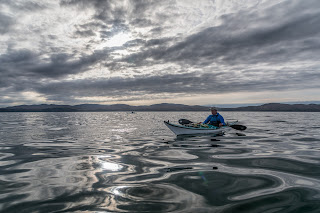Read Ian's trip summary here.
Day 1 Carsaig Bay, Argyll mainland to Glenbatrick Bay, Jura: 26km
Blog 1 Paddling and portaging in the wake of the dead.
Blog 2 Enchanted again by the remote west coast of Jura.
Day 2 Glenbatrick Bay, Jura to Kiloran Bay, Colonsay: 41km.
Blog 5 Why sea kayakers should consider carrying a PLB, unless they are full sibling to an ostrich.
Day 3 Kiloran Bay, Colondsay to Shian Bay Jura: 30km.
Blog 10 A washed up whale and an adequate supply of washed up wood on the machair of north Colonsay.
Day 4 Shian Bay, Jura to Carsaig Bay, Argyll mainland: 40km.
Blog 21 Taking a break at Red Rock.
Blog 22 End of day in Carsaig Bay.
Postscript
If you would prefer not to paddle the Corryvreckan in the conditions in this photo, you can time your traverse for slack water:
The west going flood begins +0430 HW Oban (-0100 HW Dover) at 7 to 8 knots at springs and +0515 HW Oban (-0015 HW Dover) at neaps.
The east going ebb begins -0145 HW Oban (+0515 HW Dover) up to 8 knots at springs and -0100 HW Oban (+0600 HW Dover) at neaps.
The time changes by 6.5 minutes each day between springs and neaps. The constant between HW Dover and HW Oban does vary, so most accurate times are calculated by using HW Oban times (though not if you have calculated HW Oban indirectly from HW Dover!!).
Slack water lasts up to 30 minutes at neaps. At springs there is no real slack, there is always water moving about somewhere in the Corry. These times are pretty good as long as there is high pressure. Low pressure and wind can alter timing considerably.

















































